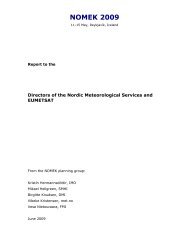International Symposium on Mitigative Measures against Snow ...
International Symposium on Mitigative Measures against Snow ...
International Symposium on Mitigative Measures against Snow ...
Create successful ePaper yourself
Turn your PDF publications into a flip-book with our unique Google optimized e-Paper software.
<str<strong>on</strong>g>Internati<strong>on</strong>al</str<strong>on</strong>g> <str<strong>on</strong>g>Symposium</str<strong>on</strong>g> <strong>on</strong> <strong>Mitigative</strong> <strong>Measures</strong> <strong>against</strong> <strong>Snow</strong> Avalanches<br />
Egilsstaðir, Iceland, March 11–14, 2008<br />
The Icelandic Meteorological Office (IMO) has used the SAMOS model for various<br />
applicati<strong>on</strong>s since the year 2000. In the following, some results of this work are summarised<br />
and methods and operati<strong>on</strong>al guidelines which have been developed are outlined briefly.<br />
2. SIMULATION OF AVALANCHES OVER A WIDE SIZE RANGE<br />
The c<strong>on</strong>cept of the standard path was introduced by Jónass<strong>on</strong> and others (1999) to define a<br />
general scale for measuring the run-out distance of avalanches. This measure of run-out is<br />
called the run-out index and is defined as the horiz<strong>on</strong>tal distance, in [hm], to the stopping<br />
positi<strong>on</strong> of an avalanche that has been transferred to the standard path from its original path.<br />
The run-out index is traditi<strong>on</strong>ally a scalar since the avalanche path is represented by a single<br />
flow-line <strong>on</strong> which the stopping positi<strong>on</strong> is a single point that can be explicitly defined by the<br />
<strong>on</strong>e-dimensi<strong>on</strong>al system horiz<strong>on</strong>tal distance al<strong>on</strong>g the flow-line [hm]. The evaluati<strong>on</strong> of runout<br />
indices relies <strong>on</strong> a slight modificati<strong>on</strong> of the traditi<strong>on</strong>al 2-parameter PCM snow avalanche<br />
model. Run-out indices have proved to be useful both to simplify the comparis<strong>on</strong> of different<br />
avalanches and to carry out a statistical analysis of the run-out of avalanches in a collecti<strong>on</strong> of<br />
different avalanche paths. The run-out index scale has been used extensively at the IMO and<br />
has gained an increased expectance since its introducti<strong>on</strong>.<br />
2.1 2D run-out index<br />
A two-dimensi<strong>on</strong>al model for snow avalanche moti<strong>on</strong> may be used to extend the run-out<br />
index c<strong>on</strong>cept to two dimensi<strong>on</strong>s. It is possible to create run-out index isolines by determining<br />
run-out indices <strong>on</strong> multiple flow-lines al<strong>on</strong>g a mountainside and interpolate between matching<br />
values. This could be suggested as a two-dimensi<strong>on</strong>al run-out index. However, this method is<br />
limited because of the inherent limitati<strong>on</strong>s of flow-line models.<br />
Figure 1 A birds view of the three-dimensi<strong>on</strong>al standard path. The parallel lines in red<br />
mark horiz<strong>on</strong>tal distance from the top in 100 m increments in the range<br />
1000−2000 m. The corresp<strong>on</strong>ding run-out indices are defined as the distance in<br />
[hm] and are thus in the range from 10−20.<br />
Flow-line models <strong>on</strong>ly c<strong>on</strong>sider the geometry of the path in the downstream directi<strong>on</strong>. This<br />
might be sufficient in an unc<strong>on</strong>fined mountainside, but frequently, topographical features such<br />
as gorges, gullies and ridges stretch al<strong>on</strong>g avalanche paths. These features, which tend to<br />
channelise or spread the flow of the avalanche, can either magnify or reduce the run-out<br />
164 Applicati<strong>on</strong> of two-dimensi<strong>on</strong>al avalanche model simulati<strong>on</strong>s at the IMO











